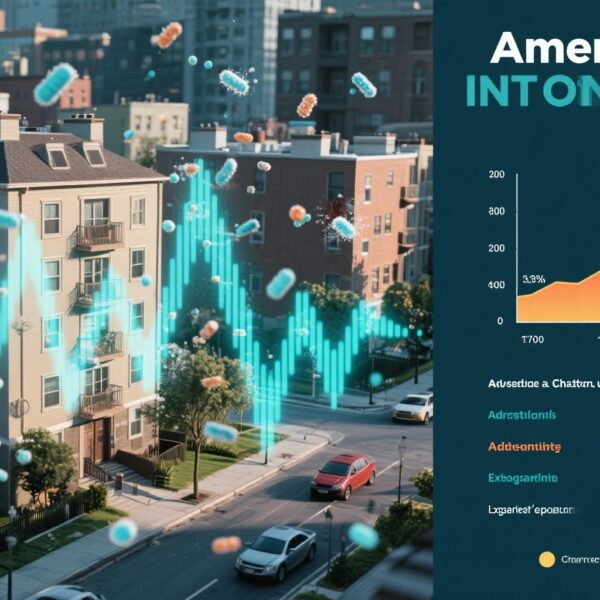Highlight
- Long-term exposure to PM2.5 is strongly associated with increased risks of incident anxiety and depression.
- Depression risks rise even at PM2.5 levels below the current EPA standard, suggesting possible underestimation of safe air quality thresholds.
- Black participants exhibit approximately double the risk of anxiety and depression compared to other racial groups, highlighting the role of systemic racism and structural inequities in environmental health outcomes.
- Findings underscore the urgent need for targeted public health interventions addressing environmental and social determinants of mental health in vulnerable communities.
Study Background and Disease Burden
Air pollution, particularly fine particulate matter with a diameter less than 2.5 micrometers (PM2.5), is a well-recognized risk factor for various physical health conditions, including cardiovascular and respiratory diseases. However, its impact on mental health remains less understood, especially across racially and socioeconomically diverse populations. Mental health disorders such as depression and anxiety constitute substantial causes of disability worldwide, with major implications for public health, healthcare utilization, and quality of life. Prior research on PM2.5 and mental health has mainly utilized cross-sectional designs or included homogeneous cohorts, limiting causal inference and generalizability.
Environmental injustices—where marginalized communities face greater pollutant exposures due to historical and systemic factors—may intensify mental health disparities. Structural racism through residential segregation, socioeconomic deprivation, and limited healthcare access further compounds these inequalities. There is a critical need for longitudinal analyses in large, diverse cohorts to better characterize the association between ambient air pollution and incident mental health outcomes, with attention to social determinants.
Study Design
This study leveraged data from the All of Us Research Program between 2018 and 2022, incorporating two prospective cohorts comprising over 100,000 participants each. The cohorts focused separately on incident depression and incident anxiety cases identified during follow-up. Exposure assessment involved assigning annual average PM2.5 concentrations based on participants’ residential zip codes, facilitating individual-level exposure estimates.
Analytic methods included Cox proportional hazards models to estimate hazard ratios (HRs) for incident mental health outcomes associated with PM2.5 exposure. The models incorporated natural cubic splines to flexibly capture exposure-response relationships and adjusted for a comprehensive set of individual-level covariates (including demographic, behavioral, and clinical variables) as well as community-level socioeconomic indicators. Effect modification by race/ethnicity, health insurance status, and neighborhood socioeconomic status was evaluated to identify vulnerable subgroups.
Key Findings
The study demonstrated statistically significant associations between increased PM2.5 exposure and higher risks of incident anxiety and depression. Specifically, for every 10 μg/m3 increase in annual average PM2.5, the hazard ratio was 2.14 (95% confidence interval [CI]: 1.41 to 3.24) for anxiety and 1.66 (95% CI: 1.02 to 2.70) for depression. When comparing participants in the highest versus lowest PM2.5 quartiles, the HR was 1.10 (95% CI: 1.03 to 1.19) for anxiety and 1.45 (95% CI: 1.33 to 1.57) for depression.
Notably, depression risks were elevated even at PM2.5 exposure levels below the Environmental Protection Agency’s (EPA) current standard of 9.0 μg/m3, suggesting that existing regulatory thresholds may not fully protect mental health. Anxiety risk increases were predominantly observed at higher pollution concentrations.
A critical dimension of the findings involved racial disparities: Black participants experienced approximately double the risk for both depression and anxiety compared to other racial groups, independent of covariates. This disparity likely reflects cumulative impacts of systemic racism manifesting as residential segregation in highly polluted areas, barriers to accessing quality healthcare, and chronic psychosocial stress. Moreover, individuals lacking insurance or residing in socioeconomically disadvantaged neighborhoods exhibited accentuated risks.
Expert Commentary
This robust prospective analysis from the All of Us Research Program contributes valuable evidence linking chronic PM2.5 exposure to incident mental health disorders in a demographically diverse American population. The use of longitudinal data strengthens causal inference, while comprehensive adjustment for confounders and evaluation of effect modification enhance interpretation of health disparities.
These findings corroborate and expand on prior research suggesting neuroinflammation and oxidative stress pathways as potential mechanisms by which air pollution may adversely affect brain function and mood regulation. The demonstration of risk increases below current air quality standards highlights a need for reevaluation of these guidelines considering mental health endpoints.
The pronounced disparities in Black participants emphasize environmental injustice as a critical domain for mental health interventions. Policies aiming to reduce pollution exposure, enhance healthcare accessibility, and mitigate socioeconomic disadvantage could help narrow these inequities. Nevertheless, limitations include potential exposure misclassification from zip code–level assignment and unmeasured confounders such as occupational exposures or psychosocial factors.
Future research integrating neuroimaging, biomarkers of inflammation, and granulated exposure data might elucidate pathophysiology further and identify protective factors.
Conclusion
This prospective cohort study provides compelling evidence that long-term exposure to fine particulate air pollution is associated with elevated risks of depression and anxiety, with notable mental health disparities by race and socioeconomic status. The elevation of depression risk at PM2.5 levels below current regulatory standards calls for public health reevaluation of safe exposure limits.
Addressing these disparities requires multifaceted strategies incorporating environmental regulation, healthcare equity, and social policy reforms. Enhanced monitoring and intervention programs targeting disproportionately affected communities could mitigate the adverse mental health consequences of air pollution. Such efforts promise to improve population mental health and advance environmental justice.
Funding and Clinicaltrials.gov
This study was supported by the National Institutes of Health and the All of Us Research Program. No clinical trial registration number was applicable as this was an observational cohort analysis.
References
Burrows K, Luo J, Cai Y, Aschebrook-Kilfoy B. Long-term PM2.5 exposure and mental health disparities: A prospective analysis of the All of Us Research Program. Environ Res. 2025 Nov 15;285(Pt 5):122691. doi: 10.1016/j.envres.2025.122691. PMID: 40858232; PMCID: PMC12428303.
Additional supporting literature:
1. Power MC et al. The relation between past exposure to fine particulate air pollution and prevalent anxiety: observational cohort study. Environ Health Perspect. 2015;123(1):24-29.
2. Chen H et al. Living near major roads and the incidence of dementia, Parkinson’s disease, and multiple sclerosis: a population-based cohort study. Lancet. 2017;389(10070):718-726.
3. Weaver MD et al. Exposure to ambient air pollution and risk of incident depressive disorder in a large community cohort. Environ Int. 2020;136:105505.
4. Clark LP, Millet DB, Marshall JD. National Patterns in Environmental Injustice and Inequality: Outdoor NO2 Air Pollution in the United States. PLoS One. 2014;9(4):e94431.



